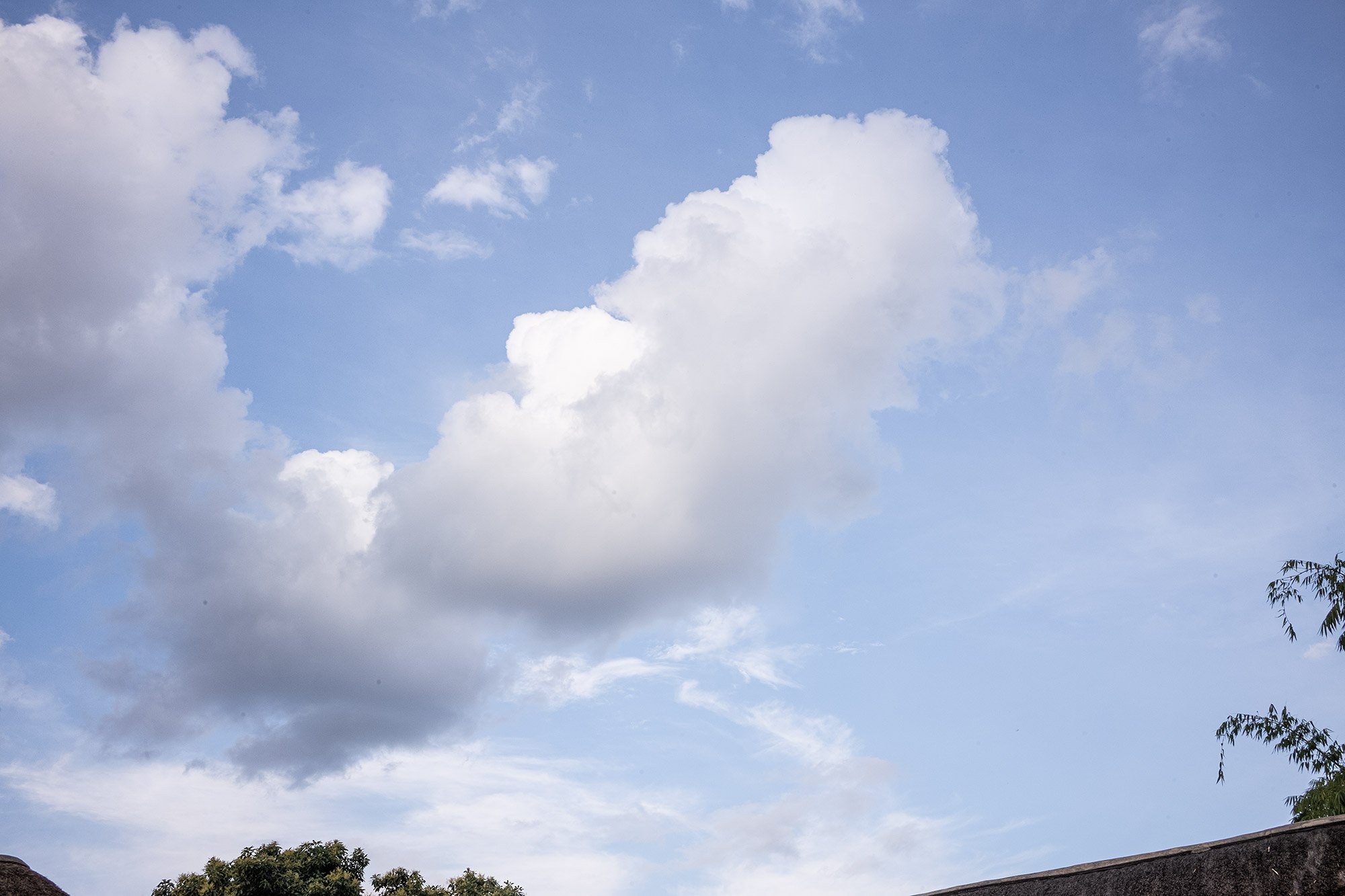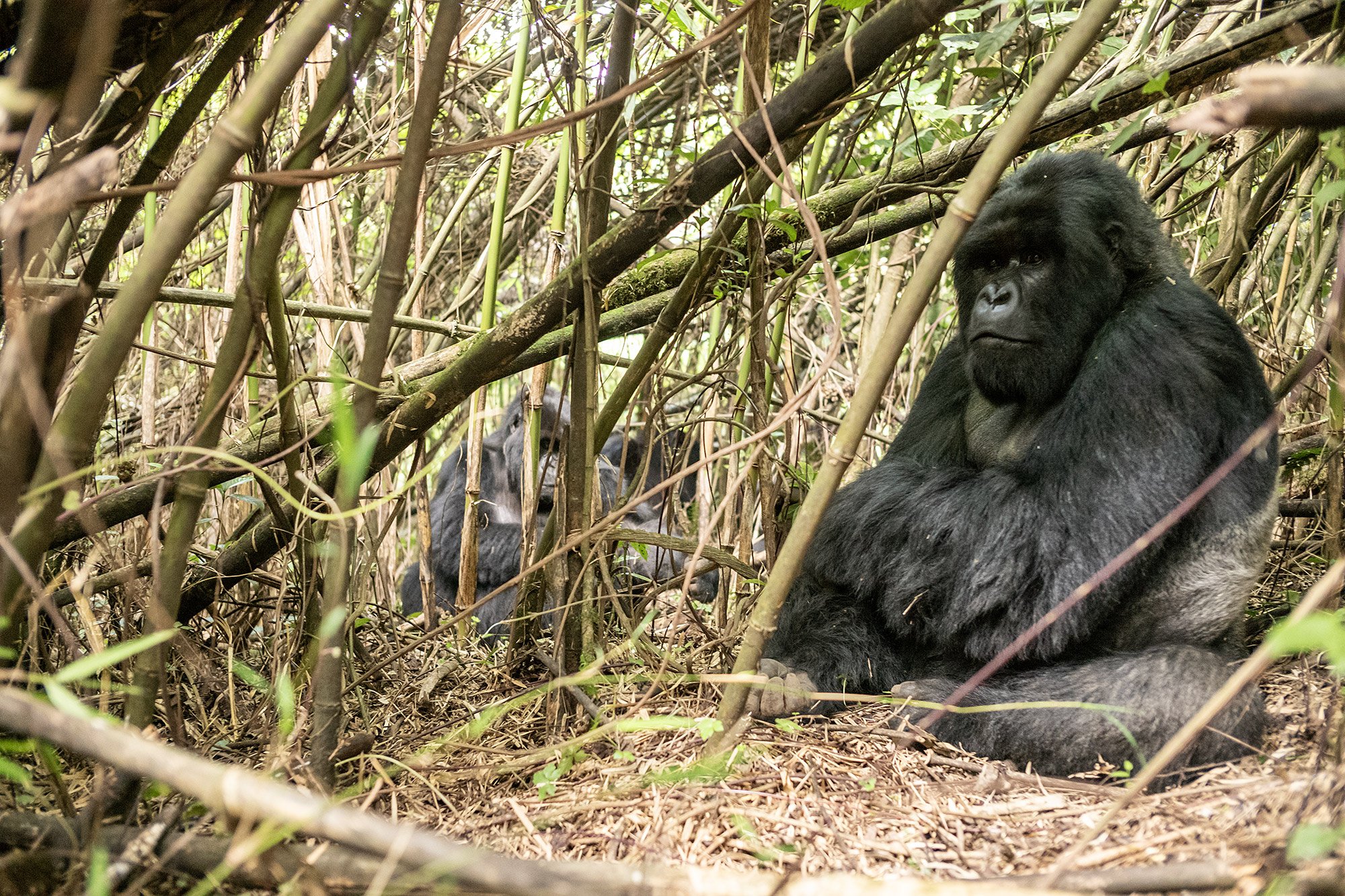
Rwanda & Uganda:
Chapter two
The mountain gorillas of Volcanoes National Park, Rwanda.
Hussein arrives promptly at 06:30. He’s probably been ready for a while, but reception waits to tell me he’s here.
In the lobby, gaiters are put over my boots to keep ants from crawling up my legs and I am handed a snack and bottles of water. Hussein tells me that there were no trekking spots available for the day, unfortunately. It was too late. However, he tells me he’s requested that I visit the largest family, Igisha, comprised of 34 gorillas. If this is my first time visiting the gorillas, I should make sure I have the greatest opportunity to see them. I thank him for his thoughtfulness.
In all, there are 24 families of gorillas in Volcanoes National Park. Twelve can be visited by toursts; the remaining 12 are reserved for researchers, though Hussein tells me that in the high season, some are made available for tourism.
We drive north through the city and into the farmland surrounding the base of the volcanoes, shrouded in cloud.
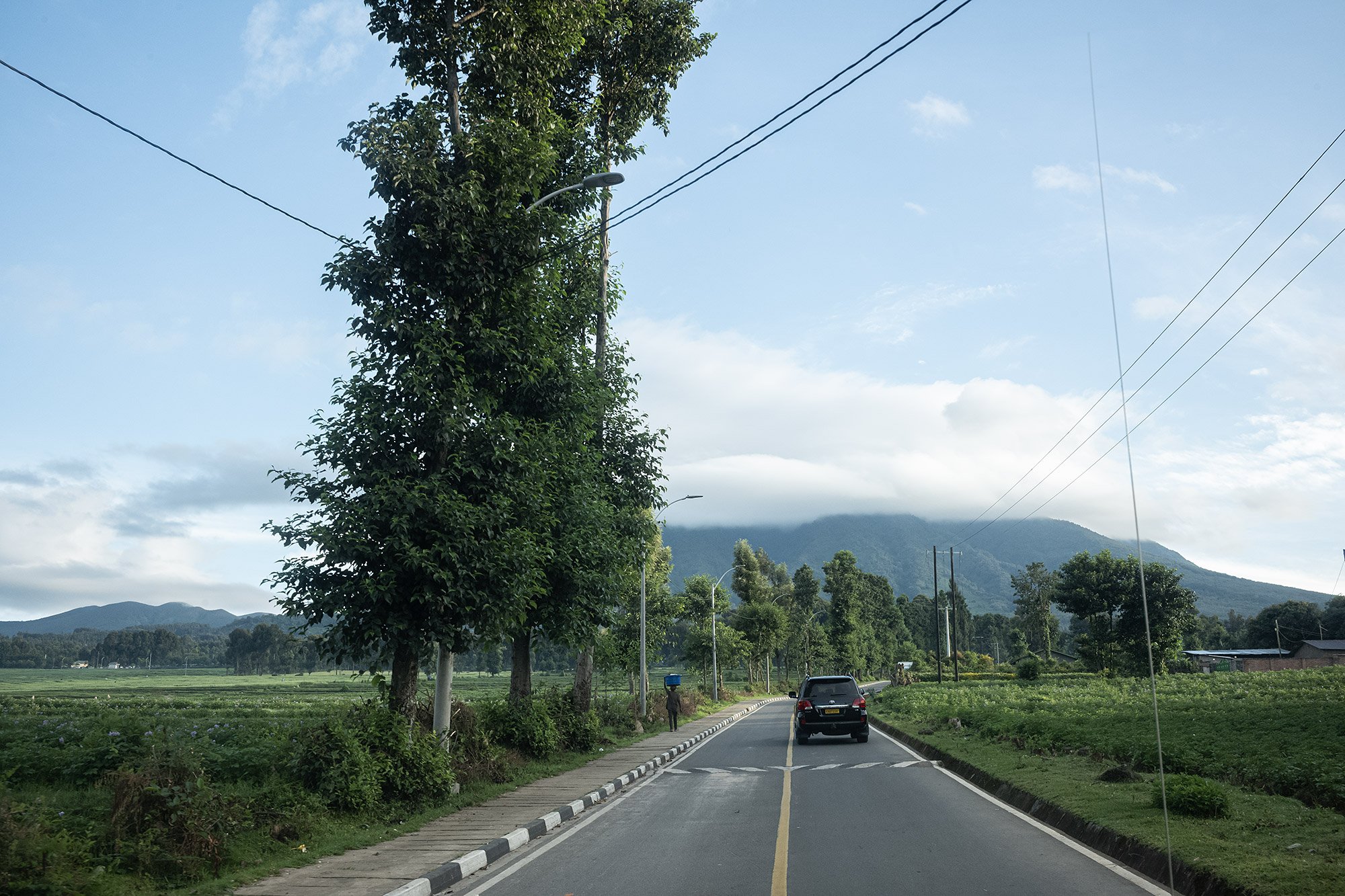
We pass an empty field dominated by a large sculpture of gorillas; Hussein tells me that’s where the gorilla naming ceremony is conducted. In September, children don masks and act as avatars for all the new baby gorillas that have been born in the past year and are named during the ceremony.

At the park entrance the car is searched and I walk through security. Hussein tells me that there have been no attacks on tourists or incidents, but that can’t be said of neighboring countries. In Rwanda, they’re practicing the maxim of better safe than sorry.
It’s a bit of a zoo on the orientation grounds. Everyone who is going gorilla or golden monkey trekking meets here. Groups of people line up in front of a small coffee shop set up in one of the huts. Others arrange themselves around various circular ampitheaters awaiting their assignments. The parking lot is full of safari jeeps and Landcruisers.
I hear my name and turn to see Mallory’s parents. She’s a coworker and a friend and told me her parents would be visiting Rwanda at the same time as me. We compared notes and realized we’d be trekking on the same day. She sent photos to each of us and they recognized me first; I am one of the only non-white tourists gathered there and probably easier to spot.
I’ve never met Mallory in person and it’s a trip to meet her parents first. We catch up quickly over their previous trip and chat about our travels and their daughter. I wish we had more time to chat, but before I know it Hussein is at my side, ready to bring me over to our trekking group.
He leads me to a group of seven lingering on the grass. Odil introduces herself as our guide for the day. She tells us there’ll be more to the briefing, but we may as well get started on our drive to the trailhead. It’s an hour and a half away, and there’ll be time enough to brief us when we arrive.
We disperse to our individual vehicles and caravan away from the orientation center. Our journey starts on sealed roads, past markets and fields until we leave the confines of Musanze and head into the villages. The road turns to dirt; the ride becomes bumpy. Nearing our destination, Hussein points out a rounded mountain on the horizon. On the other side lies the Democratic Republic of Congo.

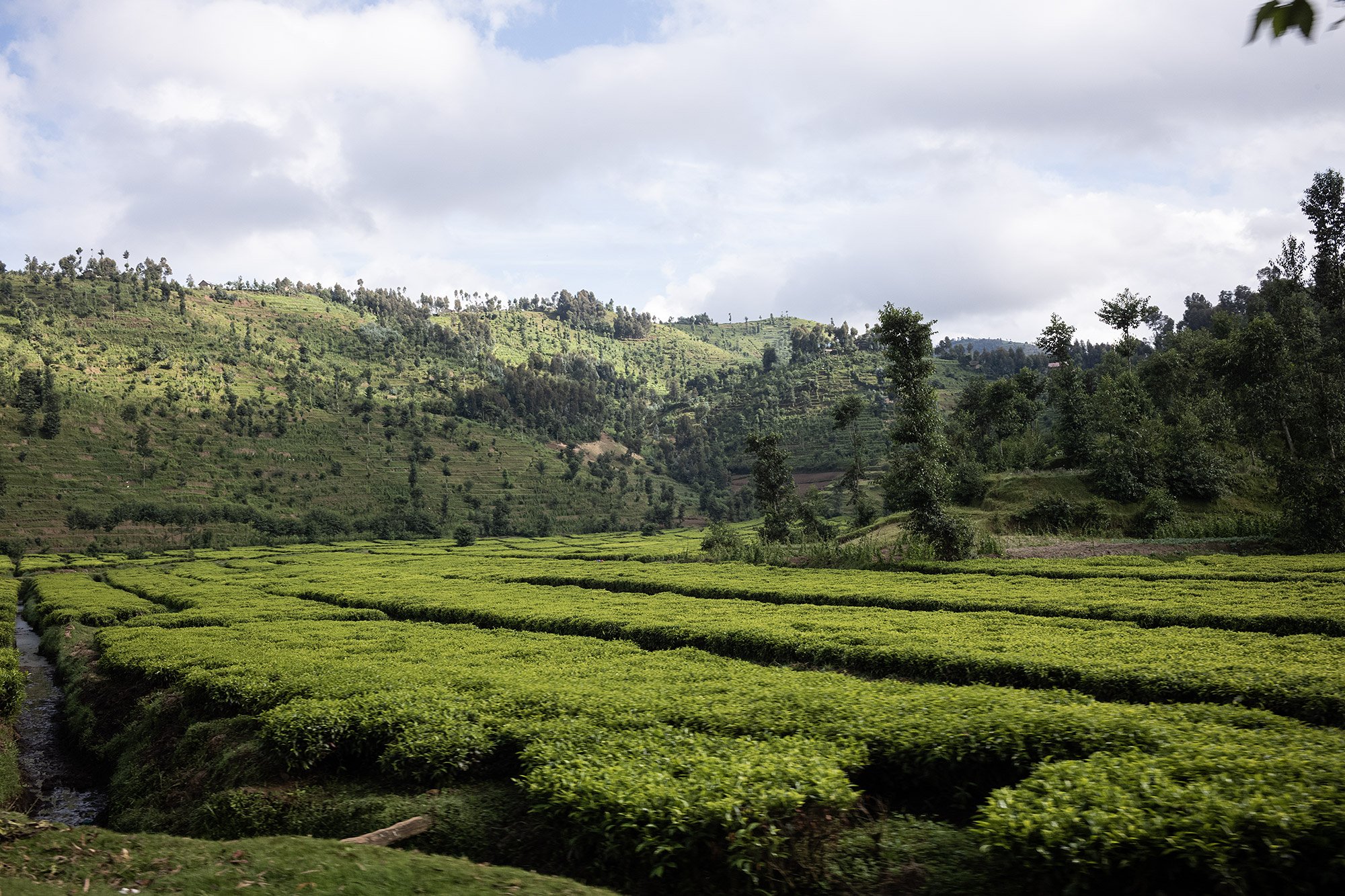



We drive through town and then into the surrounding villages. At one point, we turn off the sealed road onto a bumpy dirt road. Hussein tells me to prepare myself; we still have a long way to go.
All along the way children shout Abazungu! Abazungu! I ask Hussein what it means. Tourist or white person, he says. He tells me that they recognize the Landcruiser; even if it’s empty of tourists they’ll shout at the car.
We drive to the edge of a village and then to the edge of their fields. A group of porters awaits our arrival. Walking sticks are provided and porters acquired and Odil leads us to the edge of the forest. A ranger stands at the entrance with a gun.
Odil explains the basic etiquette of our gorilla encounter, teaching us a friendly set of two grunts: one low, the next lower. She tells us not to beat our chests in front of the gorillas as that shows aggressive behavior. If they get aggressive towards us, we’re to lower our gaze and bend our bodies as if in supplication.
She has us practice our grunts, grunting to each of us and expecting a friendly grunt in return. Satisfied, she turns to lead us into the forest.
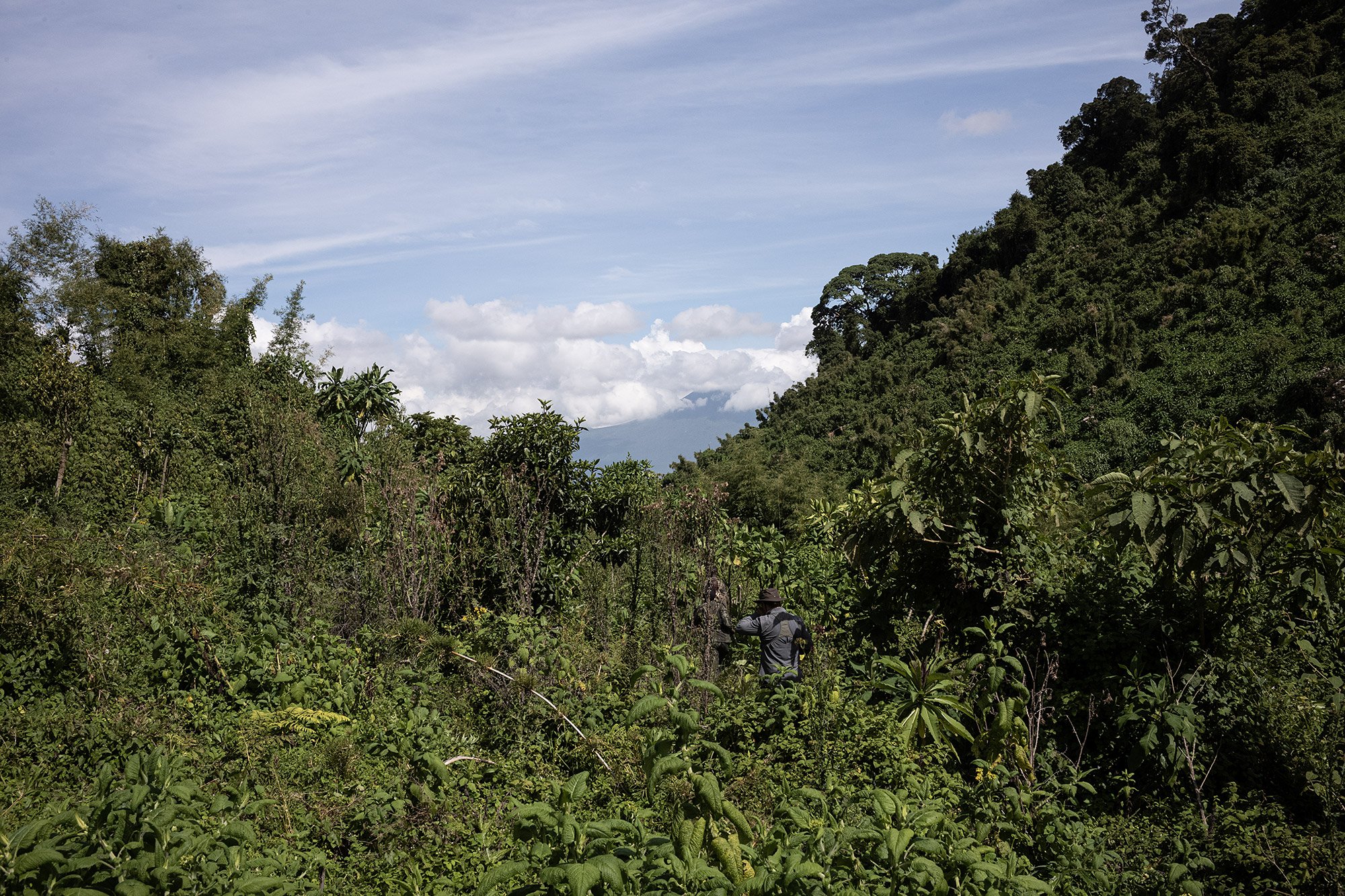

She tell us the trackers have located the family; they’re about an hour and a half away. She’ll let us know if the timing changes. The forest is dense and crowds our path. We walk single file; leaves and branches reach out to us from the bush.
Sooner than I expect, Odil tells us we are near. The gorillas have come down towards us shortening our trek. She leads us off the path deeper into the bush, in the direction of the the village. Once we are close she has us doff our packs and leave our walking sticks. She tells us to don our masks. From our staging area I can see the village below, not so far away.
We set off towards the family of gorillas, quickly finding one sunbathing in a small clearing. Another gorilla lazes in the underbrush. They pays us little mind as we observe them before they turns and raises their legs, tumbling backwards to join its mate.

Somehow, I think that’s it. It couldn’t get better than being able to see mountain gorillas in the wild in such close proximity. But one of the trackers hacks a path into the bamboo thicket and motions for me to follow. There, a mother and children hide in the shade. The children play amongst each other, climbing and falling from the bamboo before returning to the mother. One sees us and demonstrates beating its chest. We chuckle behind our masks.
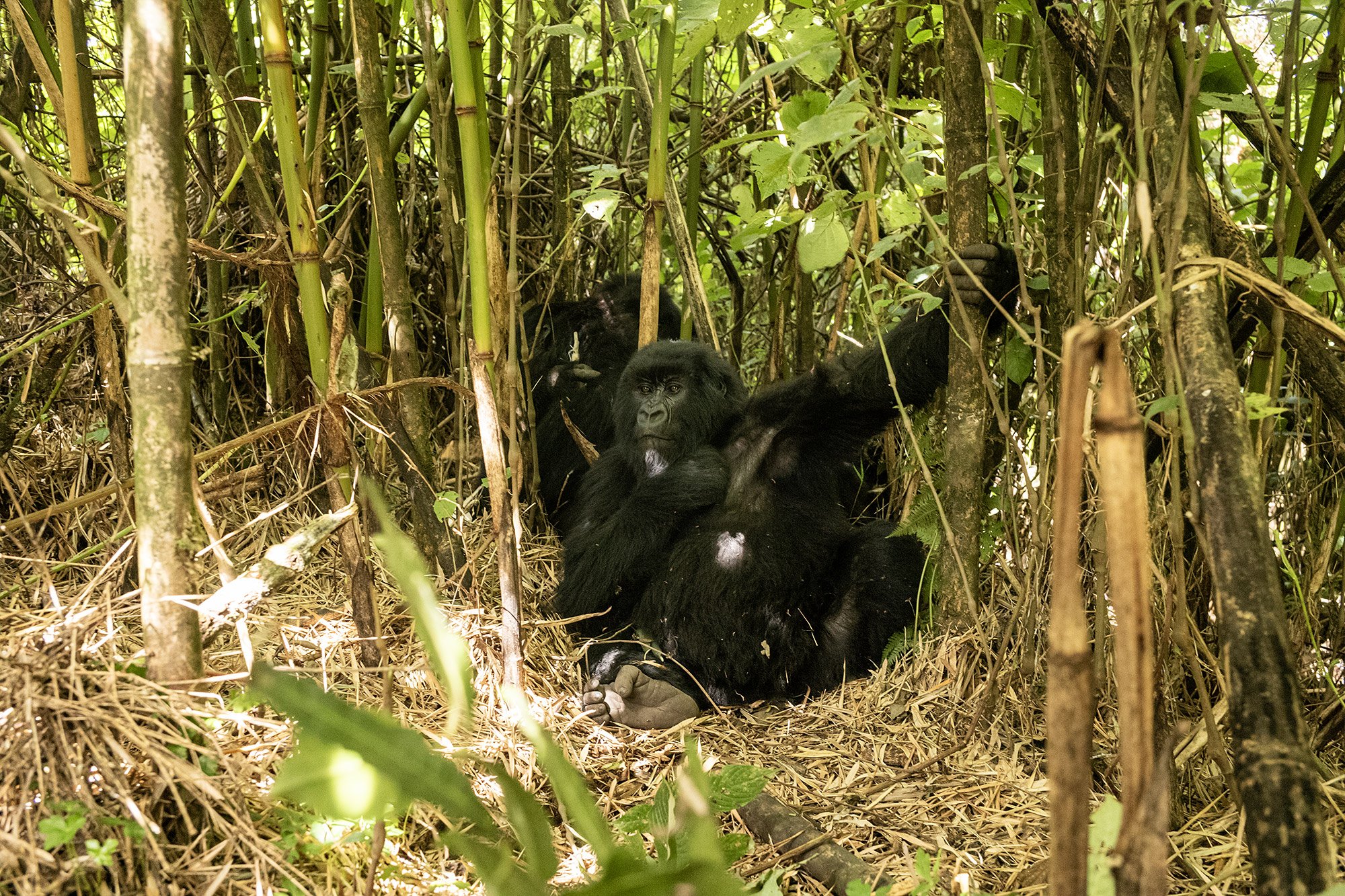


The tracker motions me on. He’s cut another path through the bamboo and soon we are following a gorilla trail, all but crawling on our hands and knees through the thicket. Beside us, gorillas are walking alongside us a few meters away.
A gorilla blocks the path before us on the path. The tracker motions to wait. I find that I’m holding onto the same fallen bamboo stalk as the gorilla and slowly let it go. The gorilla sits and glances around as if uncertain what to do. With a final glance in our direction they make up their mind and lumbers on.
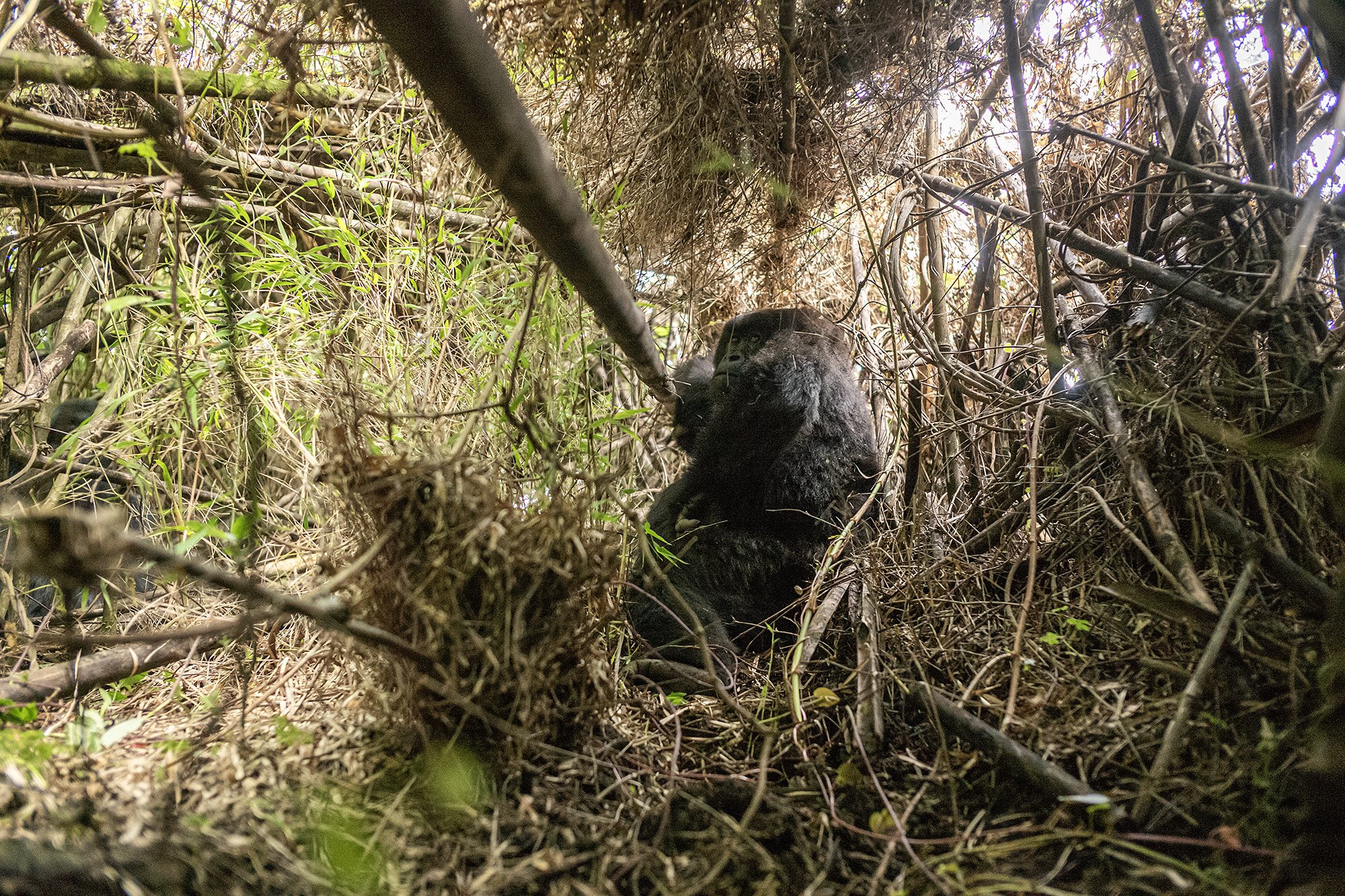
We continue along the path. The tracker makes friendly grunts as he leads us forward. Almost without warning we suddenly find ourselves face-to-face with a large silverback sitting in the thicket. Through the stalks, we can see other gorillas feeding nearby. The silverback regards us and then, assessing no threat, returns to his own thoughts.


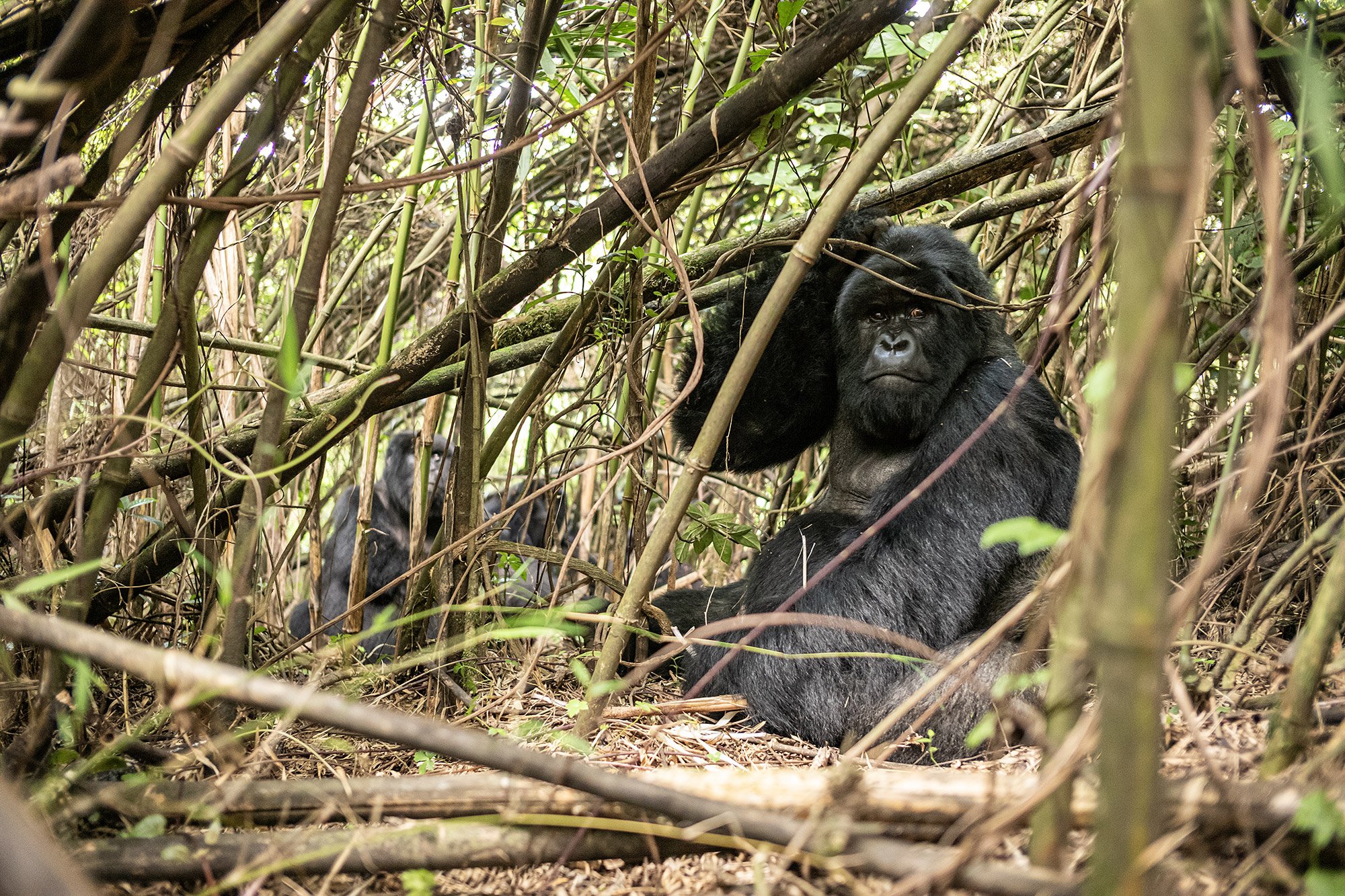
The tracker motions me forward for a better view. We’re mere meters away from the silverback and align ourselves on the path to linger breathlessly beside him until we’re lead away. There’s more to observe, though I could spend the entire hour in the presence of this magestic creature. It’s incredible being in such close proximity to creatures whose genetic makeup is in such close proximity to our own. I could sit and watch them forever.
In the Serengeti, I had told my guide he would have to nudge me to move on; I could spend the entire day watching elephants eat or wildebeest wander the savannah.


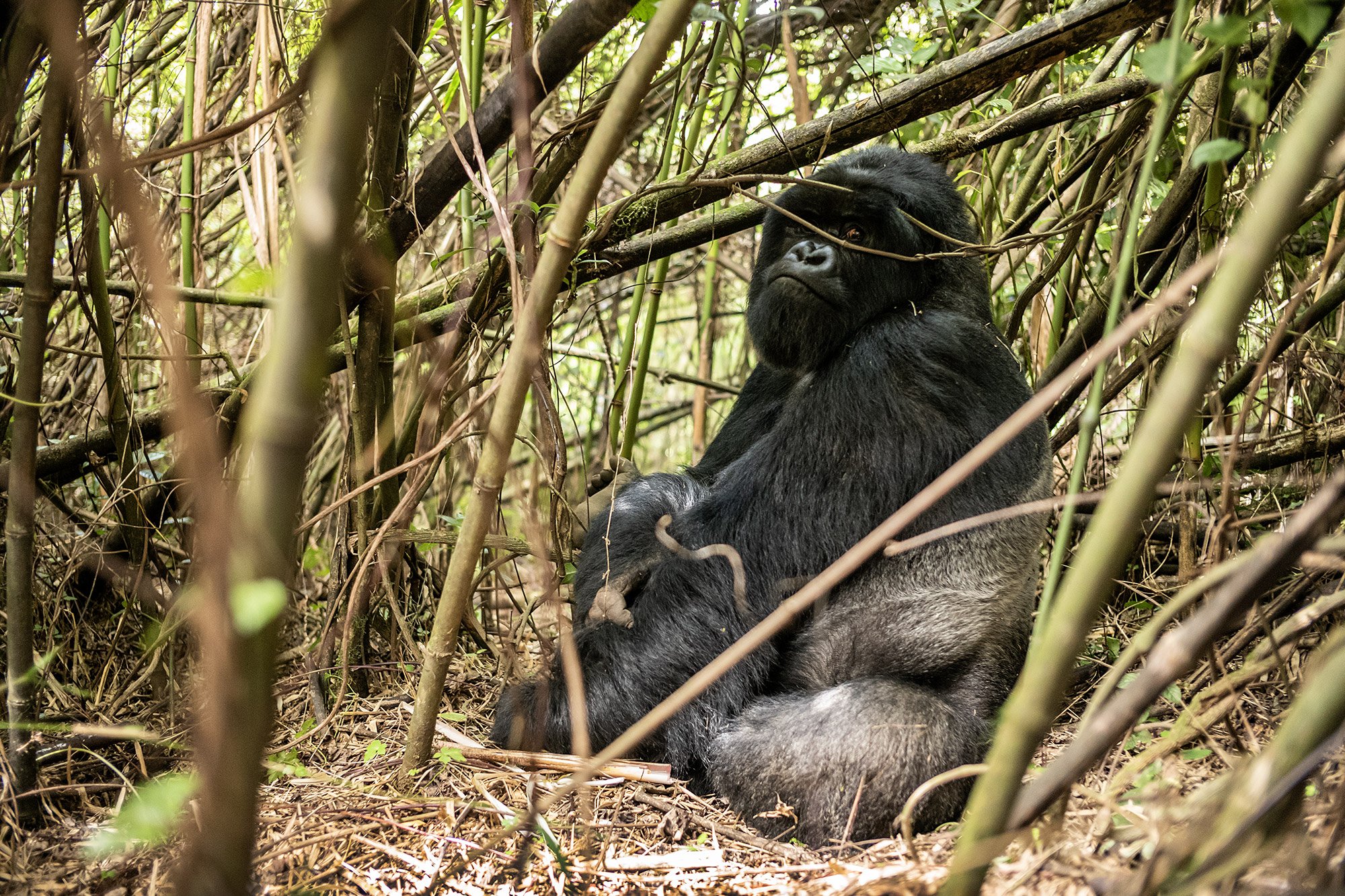
Along the path, we see fresh dung. There’s a scent of gorilla in the air, but it’s not overpowering. They’ve been habituated and are used to seeing humans. I ask if there was a period of adjustment when visitors first started wearing masks, and Odil tells me there was, but it was relatively short.
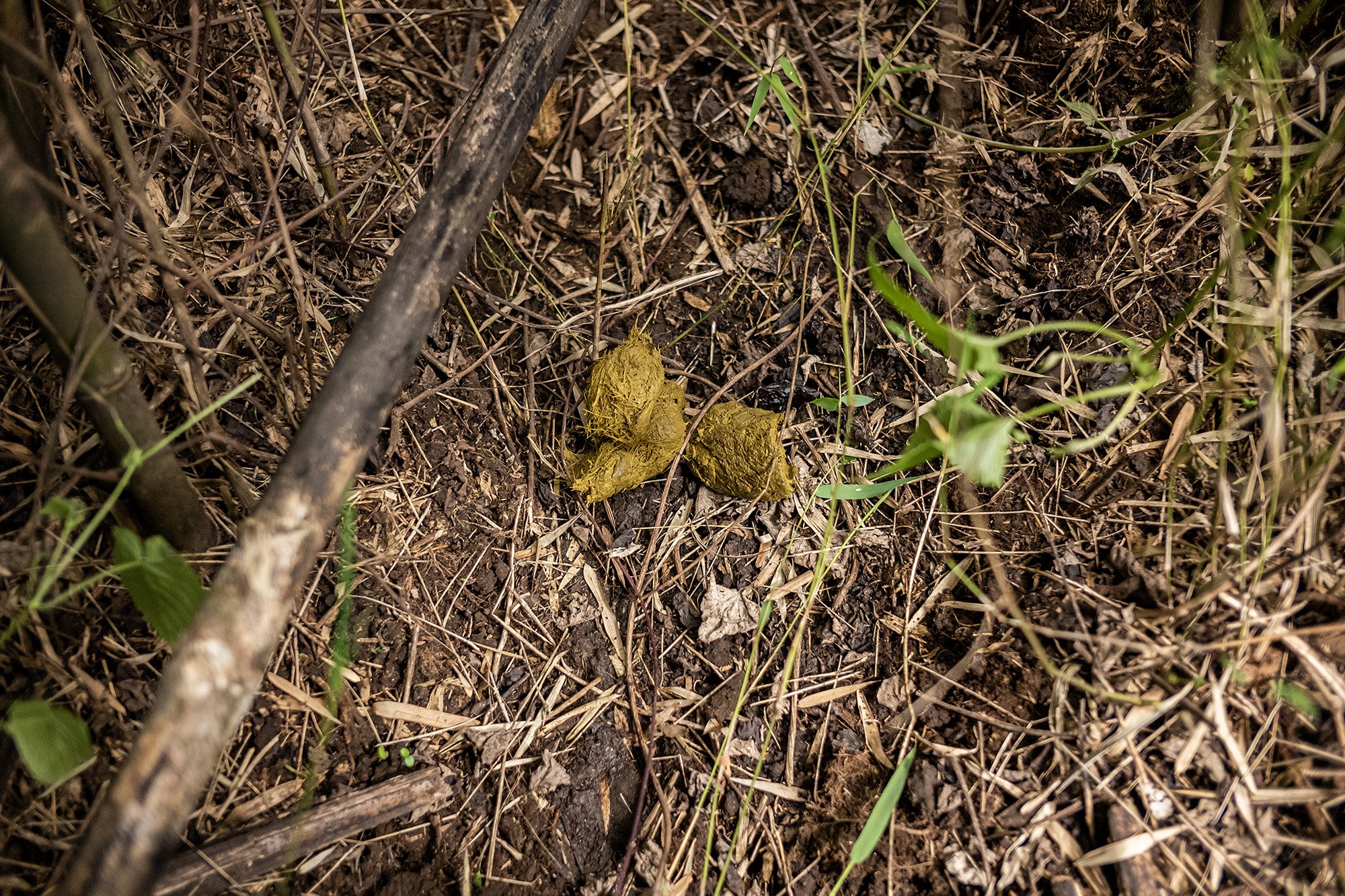
We emergefrom the bamboo to walk in the forest. A youngster hangs on the narrow trunk of a tree before us, leaves in its mouth. It takes a moment to observe us and then lowers itself to the forest floor where it disappears into the underbrush.
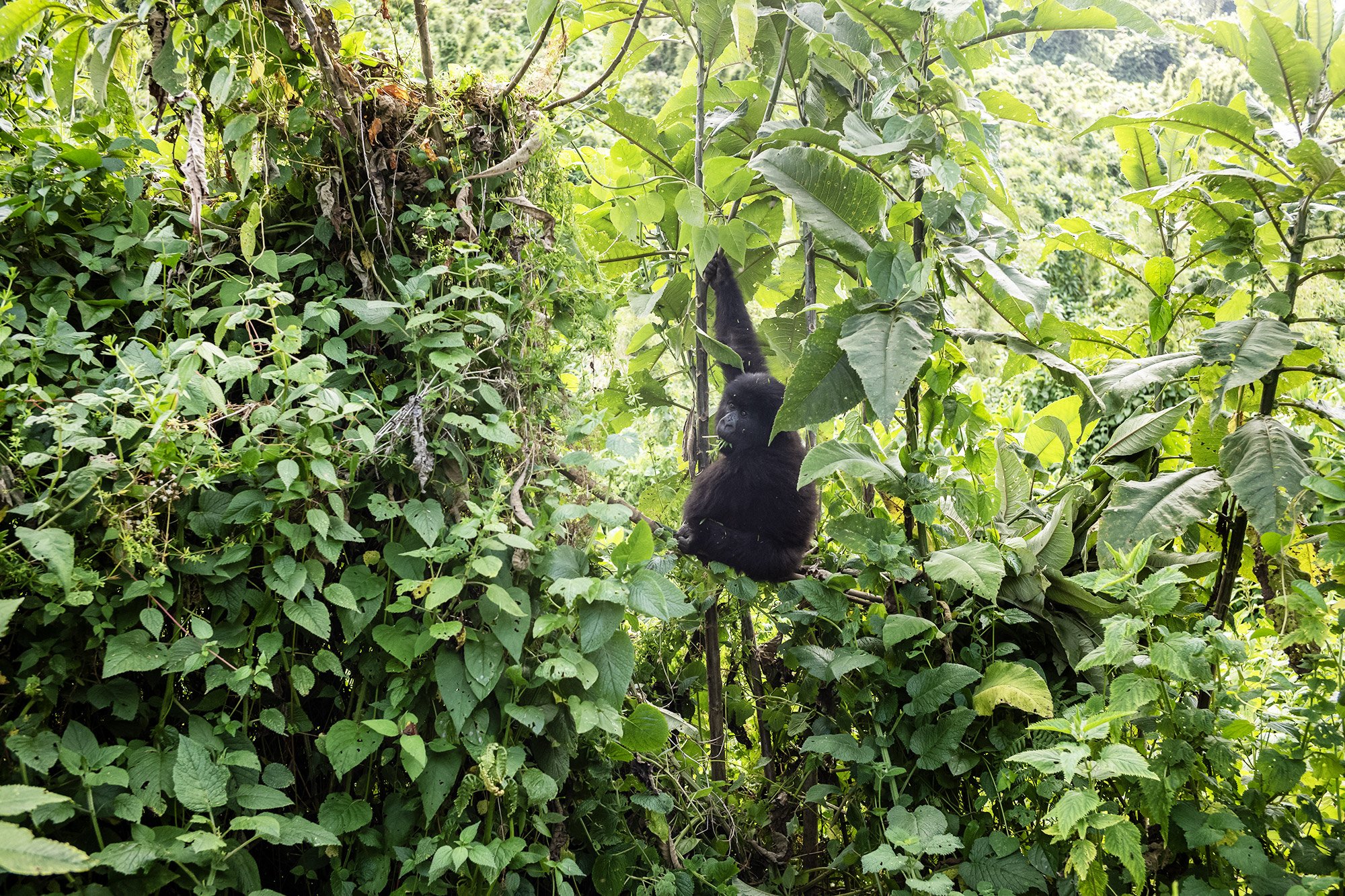
We see a young gorilla crouched next to its mother. It watches us cautiously as its mother feeds before reaching out to her and making a fuss about her body. She takes the hint and gets up to walk away from us; her baby climbs up onto her and they disappear between the leaves.
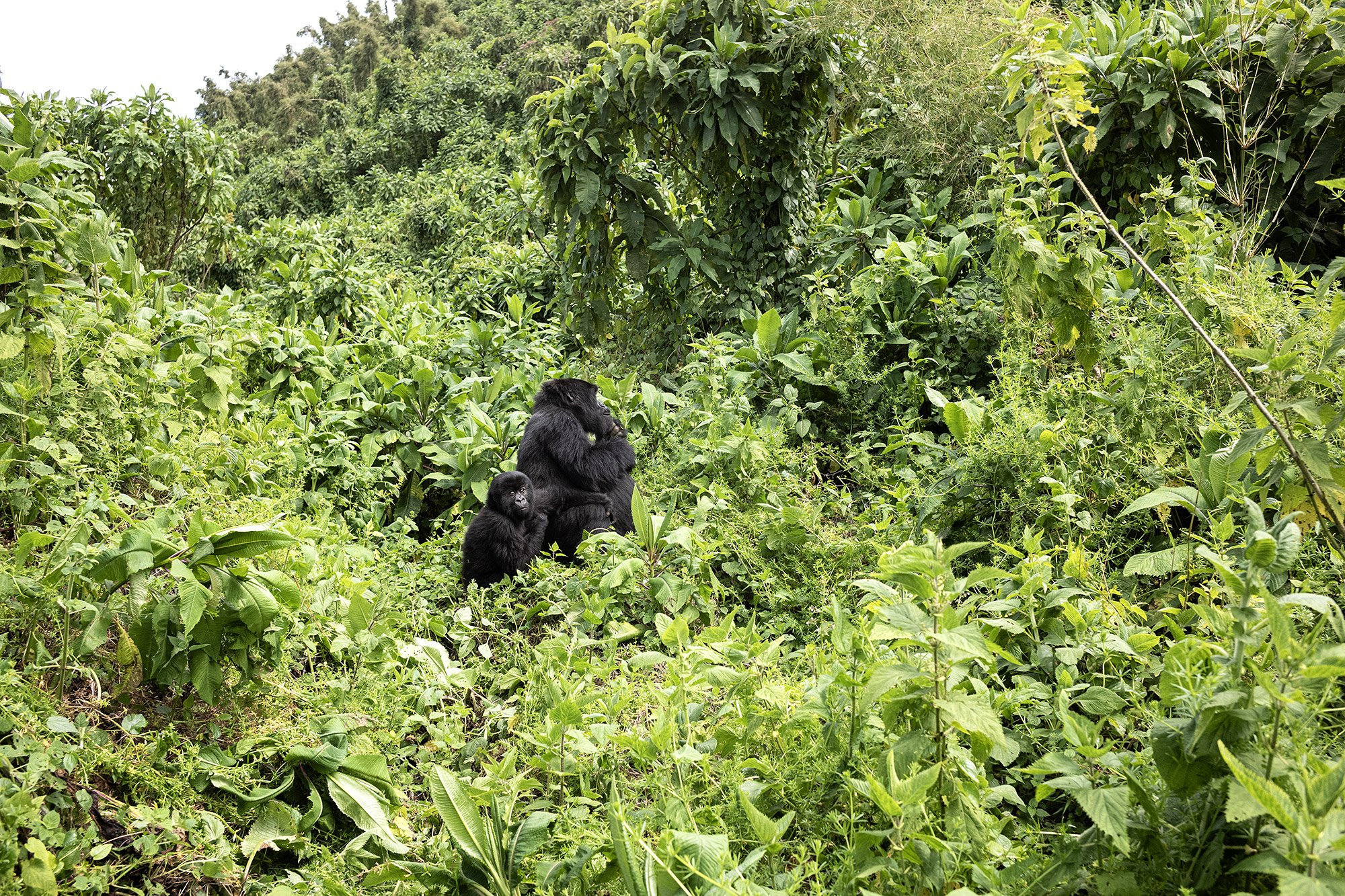
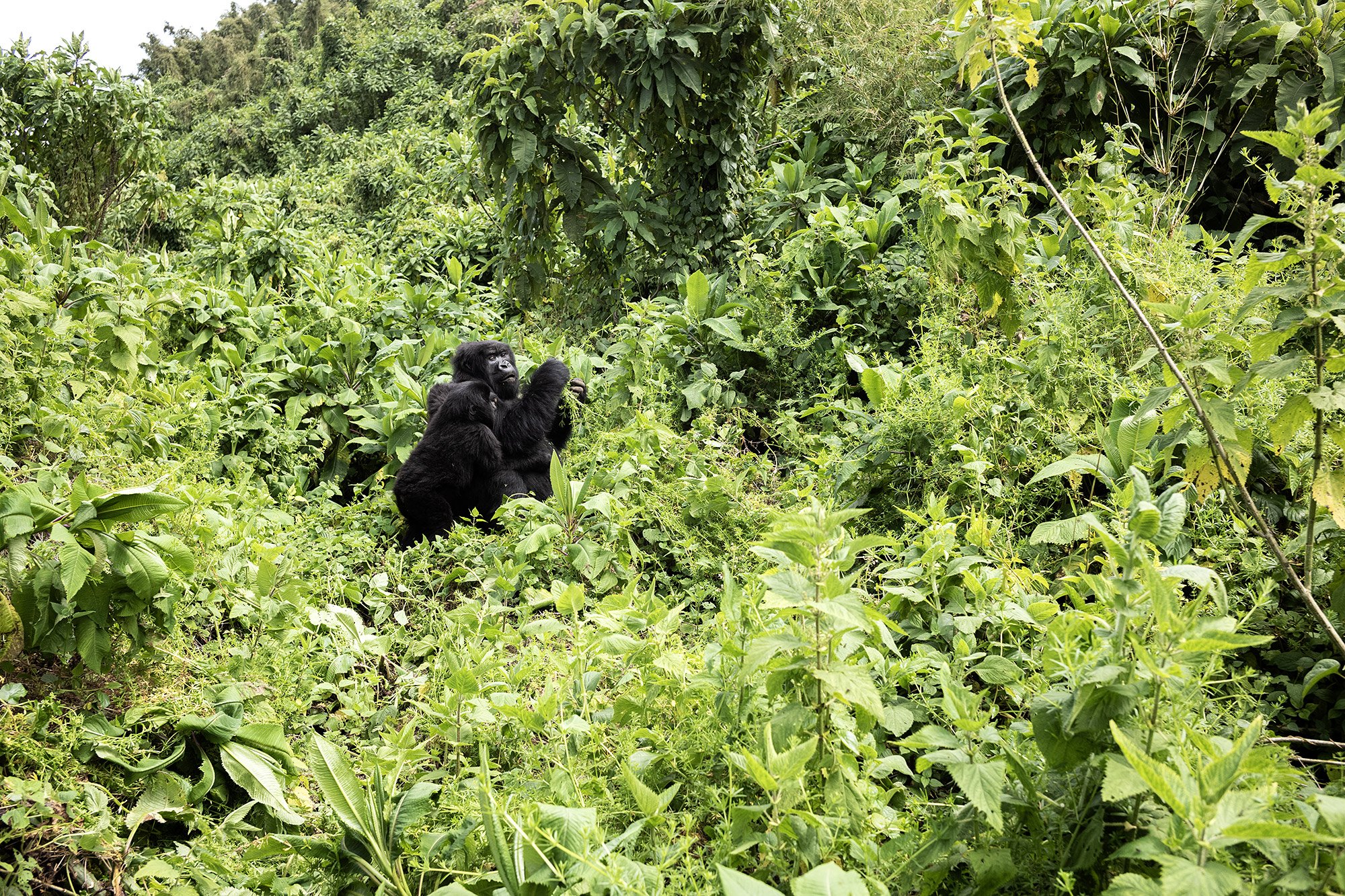

There are gorillas before us on the ground and gorillas above us in the trees; we are practically surrounded. It’s magical being amongst them in their home and I feel fortunate to have been allowed to spend time with them on their land.
As they shift and move so do we. At one point a gorilla charges us. I had been following a tracker closely as he hacked a path through the bamboo when he cut away a stalk that suddenly revealed us to each other. I feel a hand pull me back as we all reflexively take a step backwards. I swear I can hear the person behind me’s heart beating fast against their chest.
The tracker makes friednly grunts. Recognizing us as nonthreatening, the gorilla retreats to join the others in the dense forest.




I continue to follow the tracker as he makes a path to where another silverback lays in the leaves. Nearby a number of gorilla feed. The youngsters coo in delight. A gorilla gets up near to where we’re standing and walks towards us. Odil gestures to make way and the gorilla walks right in front of us, so close they practically brush against my leg.
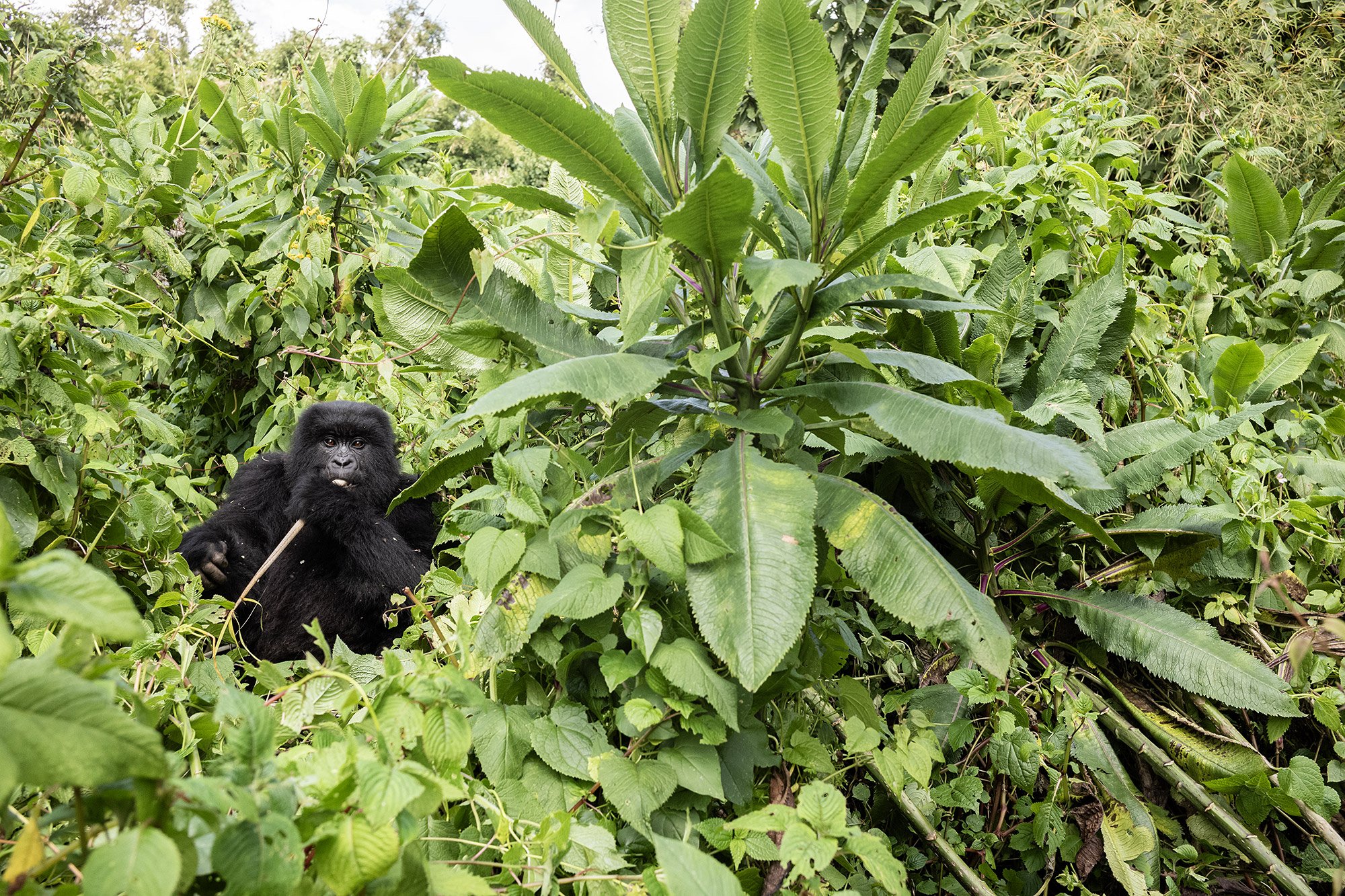

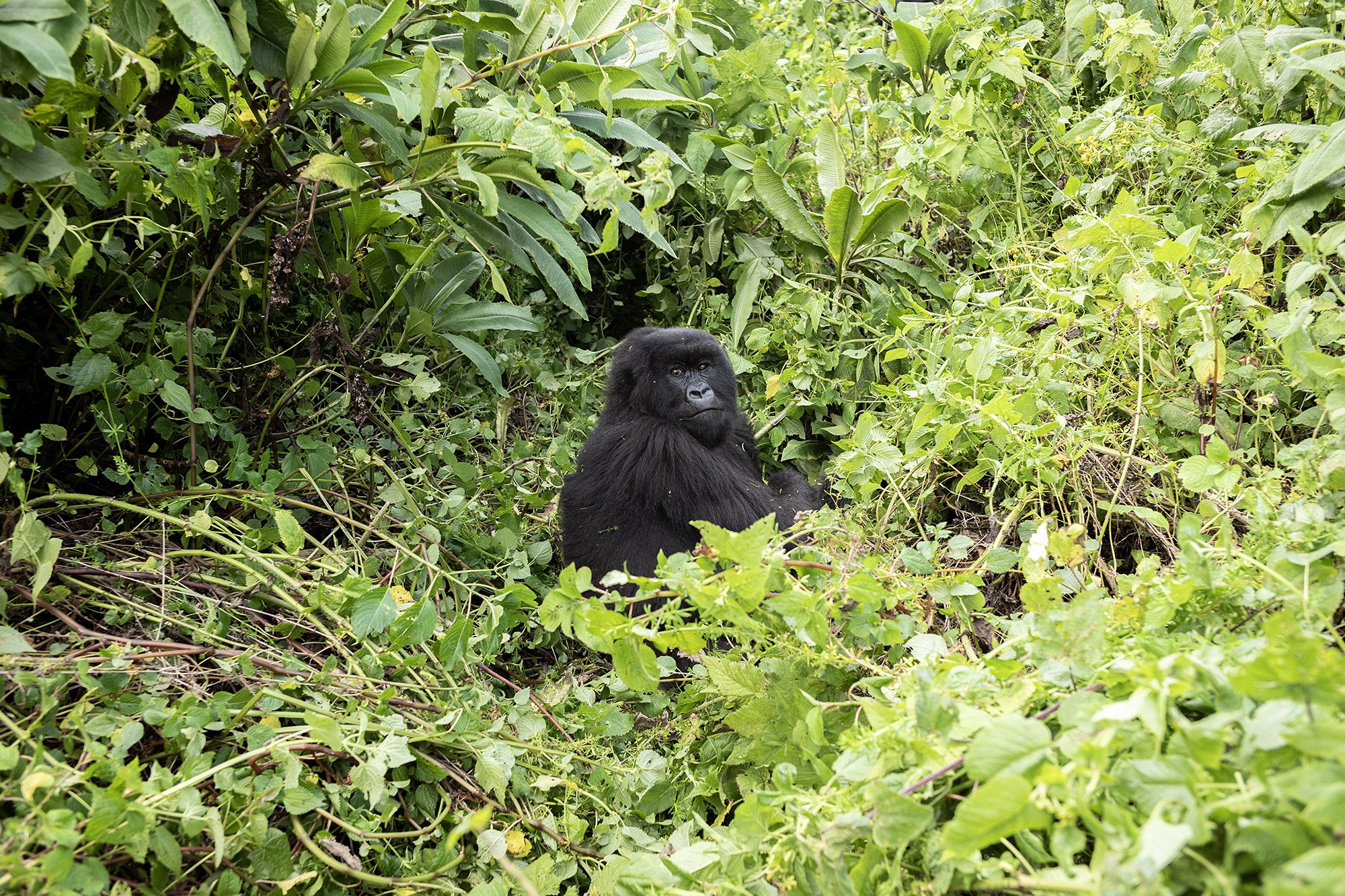
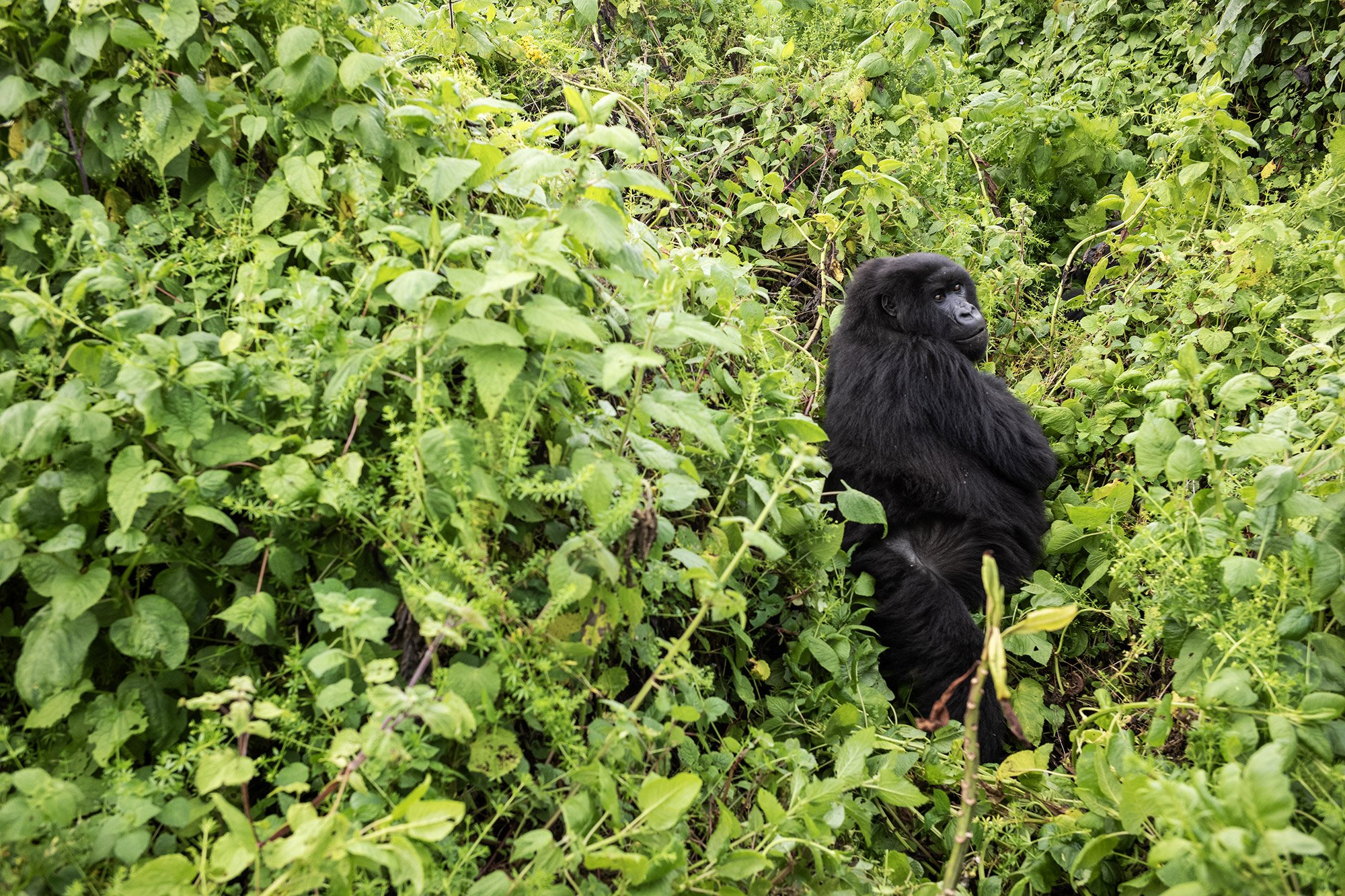

And then it is time to go. It doesn’t seem possible that an hour has passed, and it’s not until I go back through my photos that I realize the embarrassment of riches the hour has produced. Knowing our time with them is so limited—and wanting to make the most of it—seemed to make the time pass even more quickly than it did.
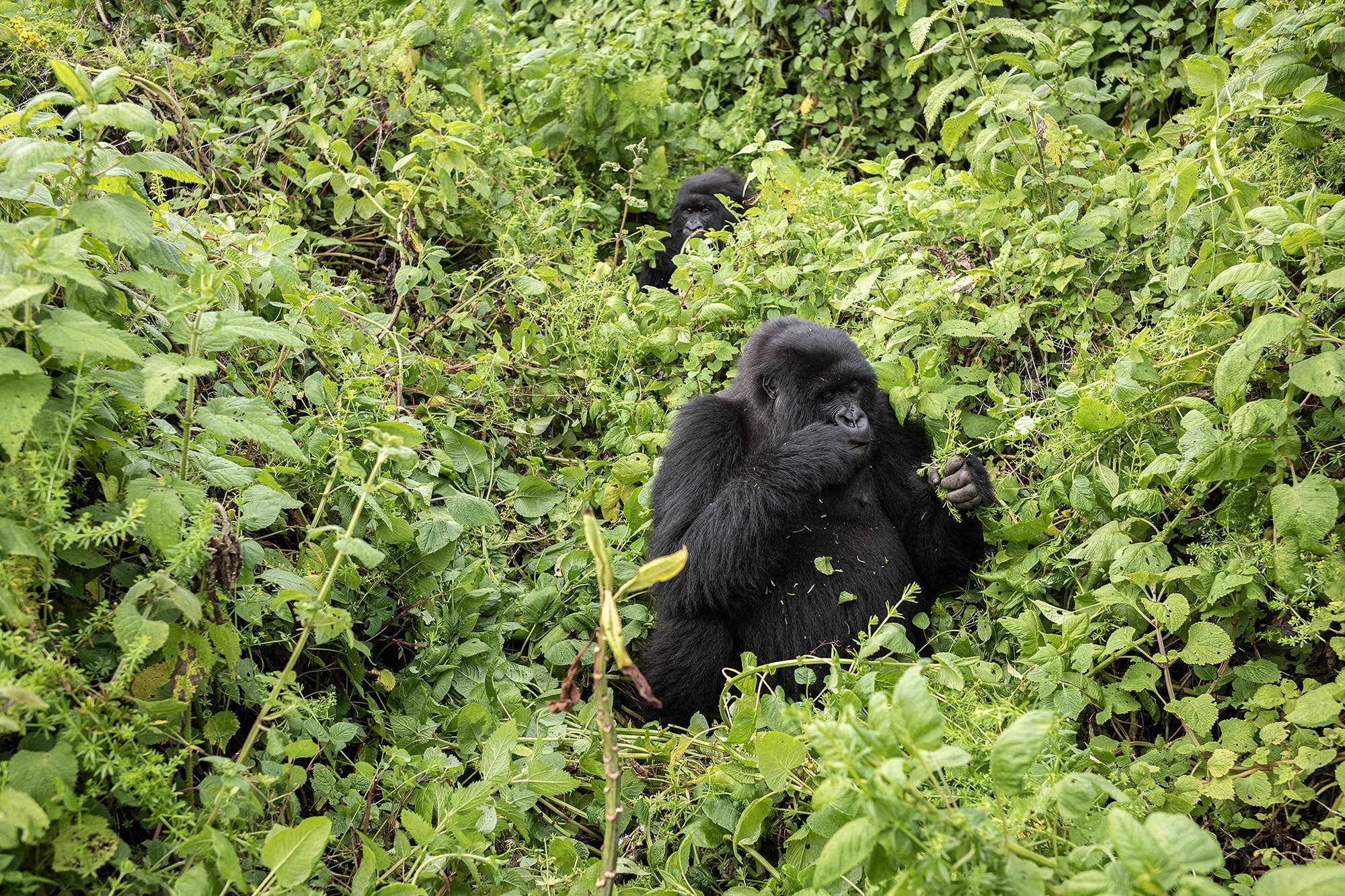
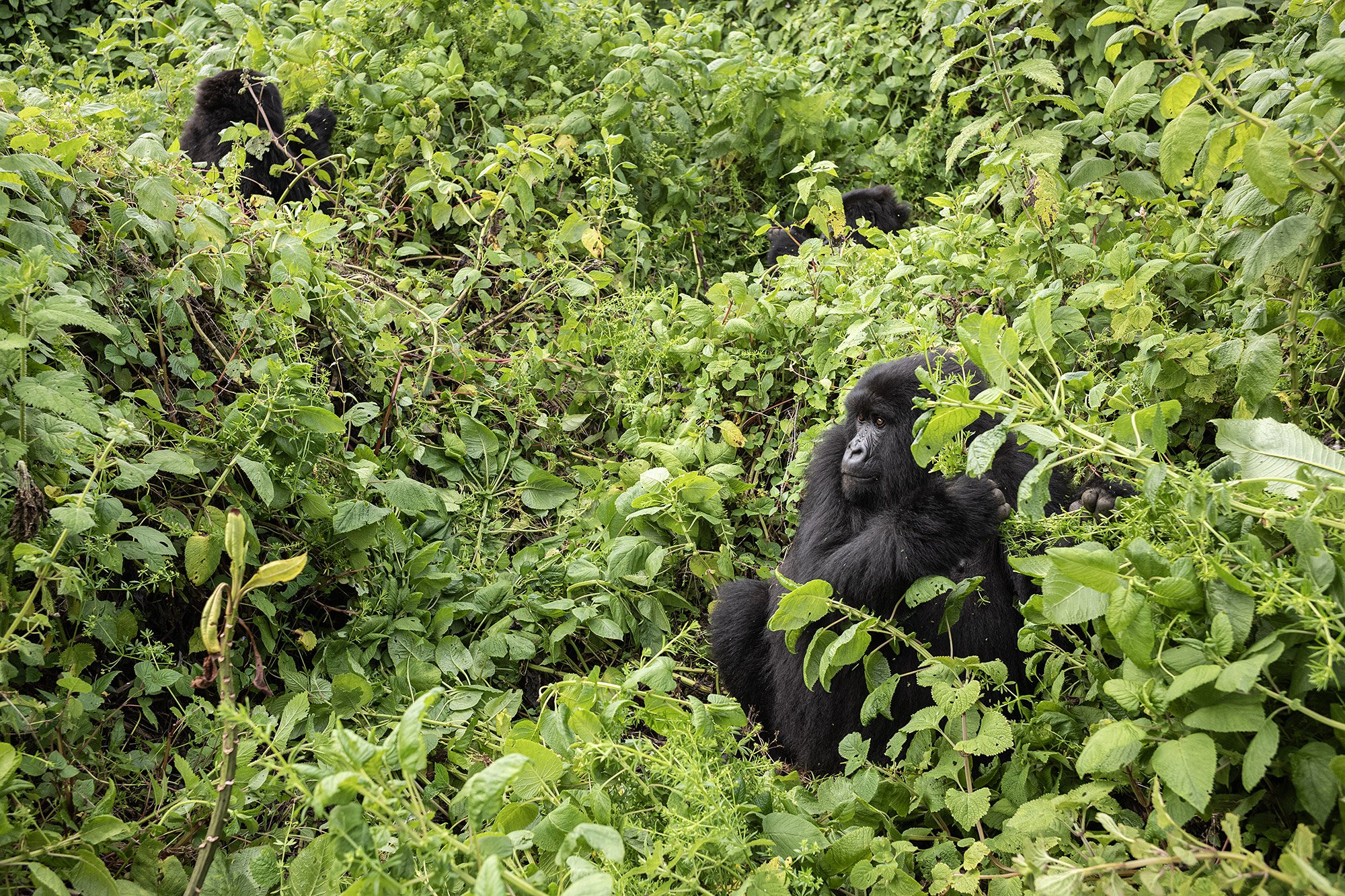
The tracker makes a path through the brush away from the family where we are met by the porters who have our bags and walking sticks. It’s surprisingly well-orchestrated, and I’m impressed by the communication between the groups.
Odil tells us that we can pause to eat our snacks before heading back to the village. She also tells us that this is where we’ll leave the trackers. They spend the entire day tracking the family, only leaving them at night so that they can once again find them in the morning.
I give my sack of snacks to the porters to share amongst themselves. I’m too excited to eat.

Our hike back to the village is surprisingly short. Along the way I ask how Odil got into guiding. She said she’d wanted to for a while and had friends who worked for the park. When they told her they were accepting applications she said she ran to the office to apply.
I ask her how many guides there are. Thirty-two, she says, of which only 3 are female. I ask her how old the oldest guide is. Sixty-seven. And how long has she been guiding? Thirteen years. I say she must have started guiding when she was seven. She laughs.
I ask if she’s ever named a gorilla. She says yes. Nziza, which means “beautiful” in Kinyarwandan
Back at the jeep two locals have set up a small table and are selling t-shirts and trinkets. I admire their entrepreneurship. Two women from our small party look over their wares, hold up t-shirts for sizing.
As we start to set off for our Pathfinders I jokingly ask Odil if she’s taking the Wilderness Pathfinder because it’s the nicest of them all. She laughs and says no; it’s heading in the direction she needs to go.
I ask her if I can take her photo and she agrees. I take a few. So many, she says. It’s all in the edit, I tell her. I ask her for her contact info so I can send them to her.

On the drive back we hear the now-familiar chorus of Abazungu! Abazungu! from children by the side of the road. It’s like a song, Hussein says as he mimics their voices in the car and laughs. I wave back to any child that waves at us. I feel like royalty.



We bump back along the road past the same villages and fields we’d seen in the morning. There’s a little more activity and I’m a little more awake so I take the time to document a few of the sights along the way: villagers collecting water from kiosks, the beautiful green fields, the finely-arranged cultivated hills.

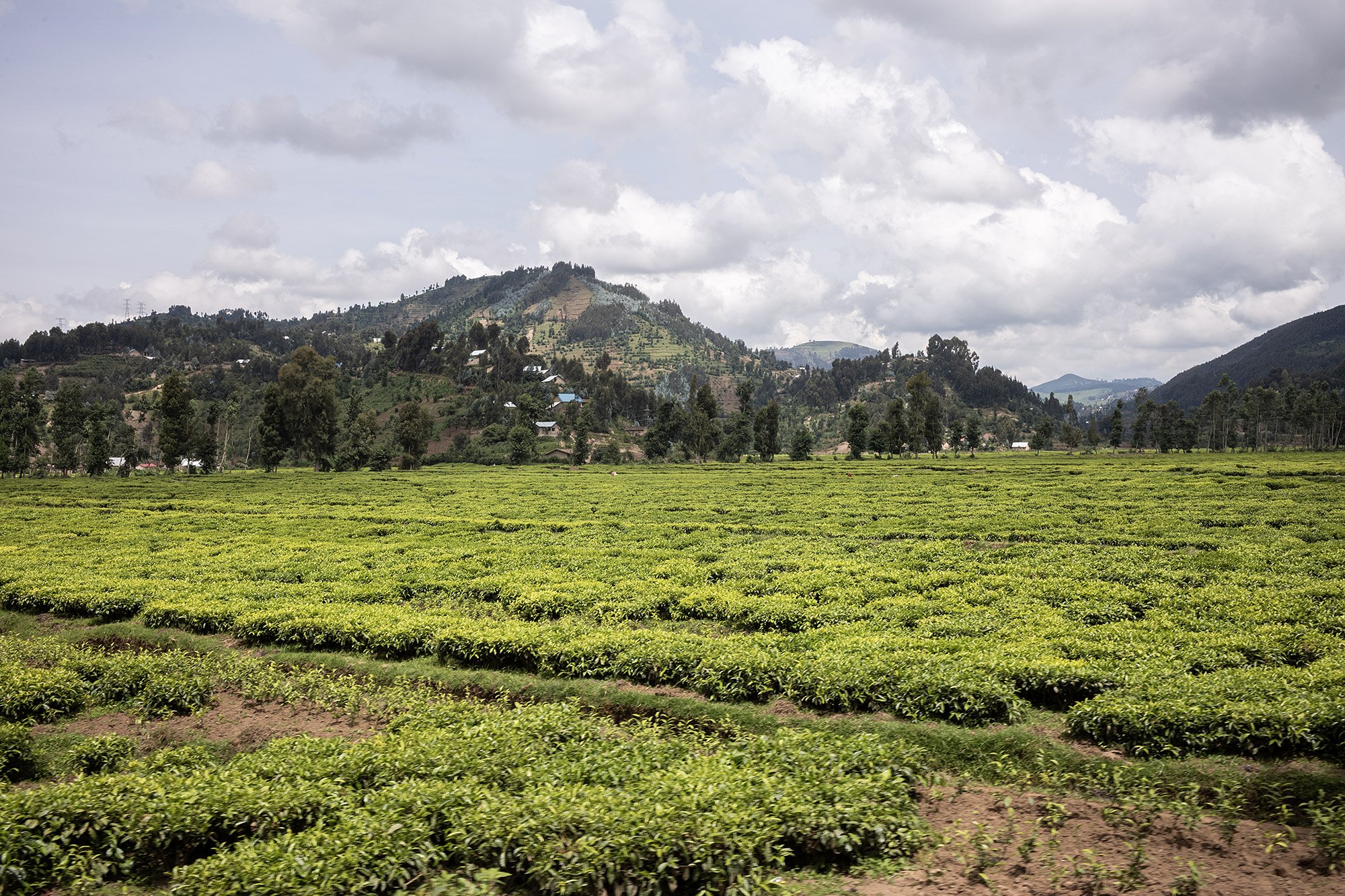


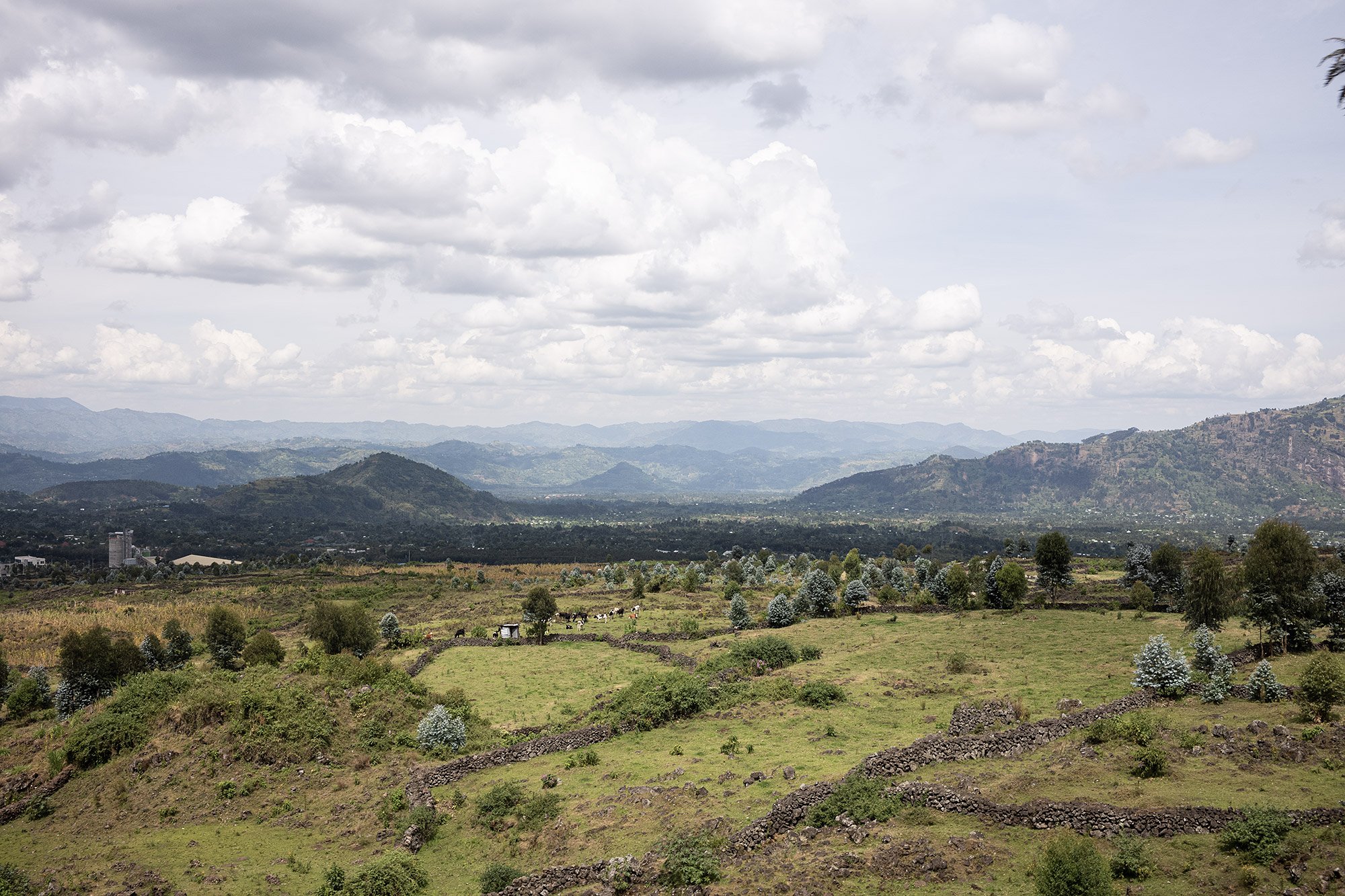
Back at the lodge, the gaiters, my shoes, and my socks are removed for me and my feet are guided into awaiting slippers. I take a quick shower and then head to lunch. I’ve picked up a copy of Gorillas in the Mist from the lodge’s library and afterwards take Dian Fossey with me to a lounge chair by the pool.
I spent many years longing to go to Africa, because of what that continent offered in its wilderness and great diversity of free-living animals, Fossey writes.
I think back to my own dreams of Africa. I think back to Mrs. Pembroke, my social studies teacher, who told us of her summer trip to Kenya in the first days of sophmore year. Africa seemed so far away and so impossible to comprehend. I didn’t even know about the mountain gorillas then. The Rwandan genocide was years away, though the seeds had long been sewn.
And now, as I write this, I’m already planning my return to Africa again, and again, and again.
11 June 2023
🦍
